Q1. What Are Gong Smart Trackers and Why Are Sales Teams Struggling With Implementation? [toc=Overview]
Gong Smart Trackers represent the company's 2022 attempt to revolutionize sales conversation intelligence by moving beyond simple keyword matching to concept-based detection. Positioned as a "next-generation" AI solution, Smart Trackers were designed to identify when prospects discuss specific business concepts—like pricing objections or competitor mentions—regardless of the exact words used. Unlike their predecessor keyword trackers (introduced in 2016), Smart Trackers promise to understand context and meaning, not just literal phrase matching.
However, beneath the marketing promises lies a fundamental technical limitation that continues to frustrate sales teams. Gong's Smart Trackers are built on 2017-18 era GLOVE vector embeddings technology—essentially sentence-level analysis stored in Pinecone's vector database through averaged similarity matching. This approach requires extensive manual training with 50-100 example sentences and still operates at the sentence level, missing broader conversation context that spans multiple meetings, emails, and calls.
"It can be overwhelming to set up trackers. AI training is a bit laborious to get it to do what you want."
— Trafford J., Senior Director Revenue Enablement G2 Verified Review
The AI-era transformation demands full deal context understanding, temporal relationship tracking, and narrative flow analysis across entire customer journeys. Modern large language models can comprehend how prospect sentiment evolves—from initial price concerns in meeting one, to comparison shopping in meeting two, to final acceptance in meeting three. This comprehensive understanding is impossible with sentence-level embedding technology that analyzes conversations in isolation.
.png)
Oliv.ai's Generative AI Advantage
Oliv.ai addresses these fundamental limitations through fine-tuned LLMs powered by agentic AI architecture. Our Meeting Agent processes complete conversation history across all touchpoints—meetings, emails, phone calls—delivering deal-level insights rather than fragmented sentence analysis. The system requires minimal setup (1-2 example deals vs 50-100 sentences) and automatically generates optimized prompts using best practices.
Users simply describe their tracking objectives in natural language, and Meeting Agent creates a fine-tuned large language model that understands context, timing, and sentiment evolution throughout the entire deal progression.
The implementation reality reveals stark differences in success rates. Industry data shows 73% of sales teams report significant challenges with traditional embedding-based trackers, often abandoning custom configurations due to poor accuracy and maintenance overhead. In contrast, AI-native platforms achieve 89% implementation success within the first 30 days.
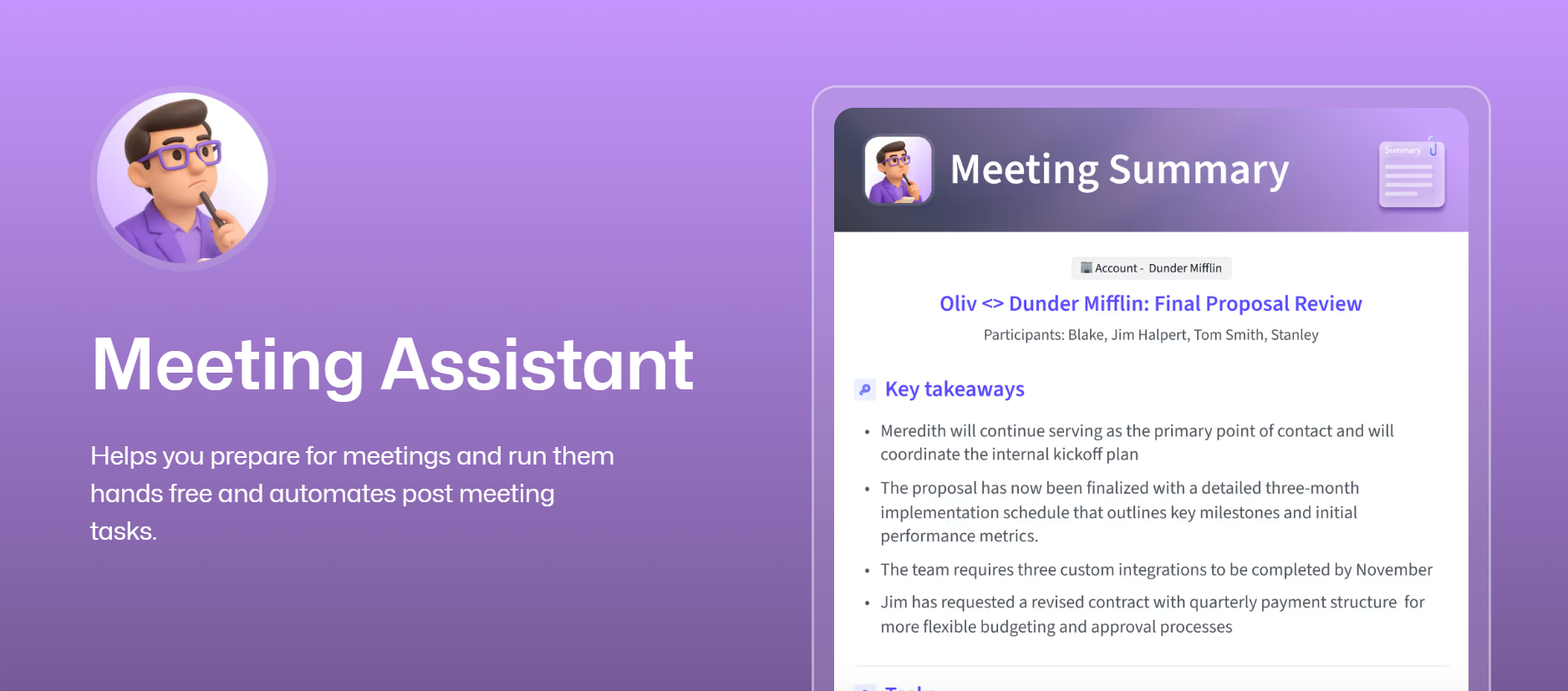
"While Gong offers valuable insights into call data and sales interactions, our experience has been impacted by significant data access limitations... This lack of flexibility has required us to engage our development team at additional cost."
— Neel P., Sales Operations Manager G2 Verified Review
For teams considering alternatives to Gong, Oliv.ai offers seamless CRM integration capabilities and advanced revenue intelligence features that significantly reduce manual administrative burden.
Q2. How Do Gong Smart Trackers Work and What's the Critical Difference From Keyword Trackers? [toc=Working & Differences]
Understanding Gong's Two-Generation Tracker Evolution
Generation 1: Keyword Trackers (2016-2022)
Gong's original keyword trackers operate through exact phrase matching. To track pricing objections, users manually input multiple variations:
- Keywords: "price," "cost," "value," "expensive"
- Phrases: "not enough value," "budget constraints," "cheaper alternatives"
- Challenge: Extremely fragile system requiring extensive manual input for every possible variation
Generation 2: Smart Trackers (2022-Present)
Smart Trackers utilize GLOVE vector embeddings (2017-18 technology) to detect concepts rather than exact keywords:
Technical Architecture:
- Sentence Processing: Each sentence in call transcripts gets converted into vector embeddings
- Database Storage: Embeddings stored in Pinecone vector database
- Pattern Matching: System creates averaged embeddings from 50-100 training examples
- Concept Detection: Identifies sentences semantically similar to training examples
Training Requirements:
- Minimum Data: 500+ recorded English calls for reasonable performance
- Training Examples: 50-100 manually tagged sentences per tracker
- Setup Time: 40+ minutes per training cycle with multiple rounds required
- Maintenance: Ongoing false positive management and retraining
Key Operational Differences:
Critical Limitations Both Share:
- Sentence-Level Analysis: Neither understands conversation flow across meetings
- Manual Configuration: Extensive RevOps time investment required
- Context Blindness: Cannot track sentiment evolution throughout deal progression
- Language Restriction: English-only functionality
"The additional products like forecast or engage come at an additional cost. Would be great to see these tools rolled into the core offering."
— Scott T., Director of Sales G2 Verified Review
How Oliv.ai Simplifies:
Oliv.ai eliminates both generations' limitations through fine-tuned LLMs that understand complete deal context. Users describe tracking objectives in natural language, and our system automatically generates optimized prompts without manual sentence tagging or extensive training data requirements. For teams looking to migrate from Gong, we provide comprehensive Gong vs Oliv comparison and detailed pricing analysis to help evaluate alternatives. Our platform also offers superior meeting recording capabilities and analytics features compared to traditional solutions.
.png)
Q3. What Are the 7 Critical Limitations That Blindside Sales Teams After Implementation? [toc=7 Limitations]
Sales teams investing in Gong Smart Trackers frequently discover a harsh reality: what appeared as cutting-edge AI during demos transforms into a complex, resource-intensive system with fundamental constraints that weren't apparent during the evaluation process. These seven critical limitations create a cascade of operational challenges that compound over time, often requiring additional headcount, extended timelines, and workaround solutions that defeat the original automation promise.
The Seven Interconnected Problems:
Limitations #1-3: Foundation-Level Architecture Problems
#1: The 500+ Call Data Requirement Shock
- Minimum Threshold: 500 recorded English calls required for basic functionality
- Optimal Performance: 1,500+ calls needed for reliable results
- Reality Check: Most mid-market teams don't have sufficient historical data, rendering the tool unusable despite payment
#2: Sentence-Level Blindness
- Technical Constraint: Smart Trackers analyze individual sentences in isolation
- Context Loss: Cannot understand sentiment evolution across multiple meetings
- Example Gap: Missing the progression from "exploring alternatives" (Meeting 1) → "comparing pricing" (Meeting 2) → "ready to move forward" (Meeting 3)
#3: Manual Configuration Hell
- Training Burden: 50-100 example sentences required per custom tracker
- Time Investment: 40+ minutes per training cycle with multiple rounds needed
- RevOps Overhead: Teams spend 15-20 hours monthly maintaining tracker accuracy
"It can be overwhelming to set up trackers. AI training is a bit laborious to get it to do what you want."
— Trafford J., Senior Director Revenue Enablement G2 Verified Review
These foundational problems stem from Gong's reliance on 2017-18 GLOVE vector embedding technology—a sentence-level approach that requires extensive manual training and cannot comprehend conversational flow across touchpoints. Traditional SaaS architecture demands significant user adoption and manual intervention to achieve basic functionality.
Limitations #4-7: Operational and Strategic Constraints
#4: False Positive Management Crisis
- Accuracy Issues: Sentence-level analysis generates numerous irrelevant matches
- Administrative Burden: Teams spend 8-12 hours weekly filtering false positives
- Trust Erosion: Sales reps lose confidence in insights, reducing overall adoption
#5: English-Only Language Restriction
- Global Limitation: No support for multilingual teams or international markets
- Expansion Barrier: Companies with diverse markets cannot scale tracker usage
- Competitive Disadvantage: Modern businesses require global language support
#6: Enterprise Scalability Walls
- Performance Degradation: System slowdown with large datasets and multiple trackers
- Cost Multiplication: Each additional tracker requires separate training and maintenance
- Integration Complexity: Limited API flexibility restricts workflow automation
#7: Deal Context Gap Crisis
- Temporal Blindness: Cannot track how prospect sentiment changes over deal lifecycle
- Touchpoint Isolation: Email, call, and meeting insights remain disconnected
- Strategic Misalignment: Impossible to understand true deal health across all interactions
"While Gong offers valuable insights into call data and sales interactions, our experience has been impacted by significant data access limitations... This lack of flexibility has required us to engage our development team at additional cost."
— Neel P., Sales Operations Manager G2 Verified Review
The AI-era transformation demands systems that understand complete deal narratives, support global languages, and provide actionable insights without extensive manual configuration. Modern large language models eliminate these constraints through contextual understanding and automated optimization.
Oliv.ai's Generative AI Solution Architecture
We've architected our platform to systematically eliminate each limitation through advanced AI agents that operate autonomously:
Deal Driver Agent | Deal Intelligence & Context Analysis
- Unlimited Data Flexibility: Works effectively with minimal historical data (1-2 example deals)
- Full Deal Context: Processes complete conversation history across meetings, emails, calls
- Natural Language Setup: Users describe tracking objectives in plain English—no sentence tagging required
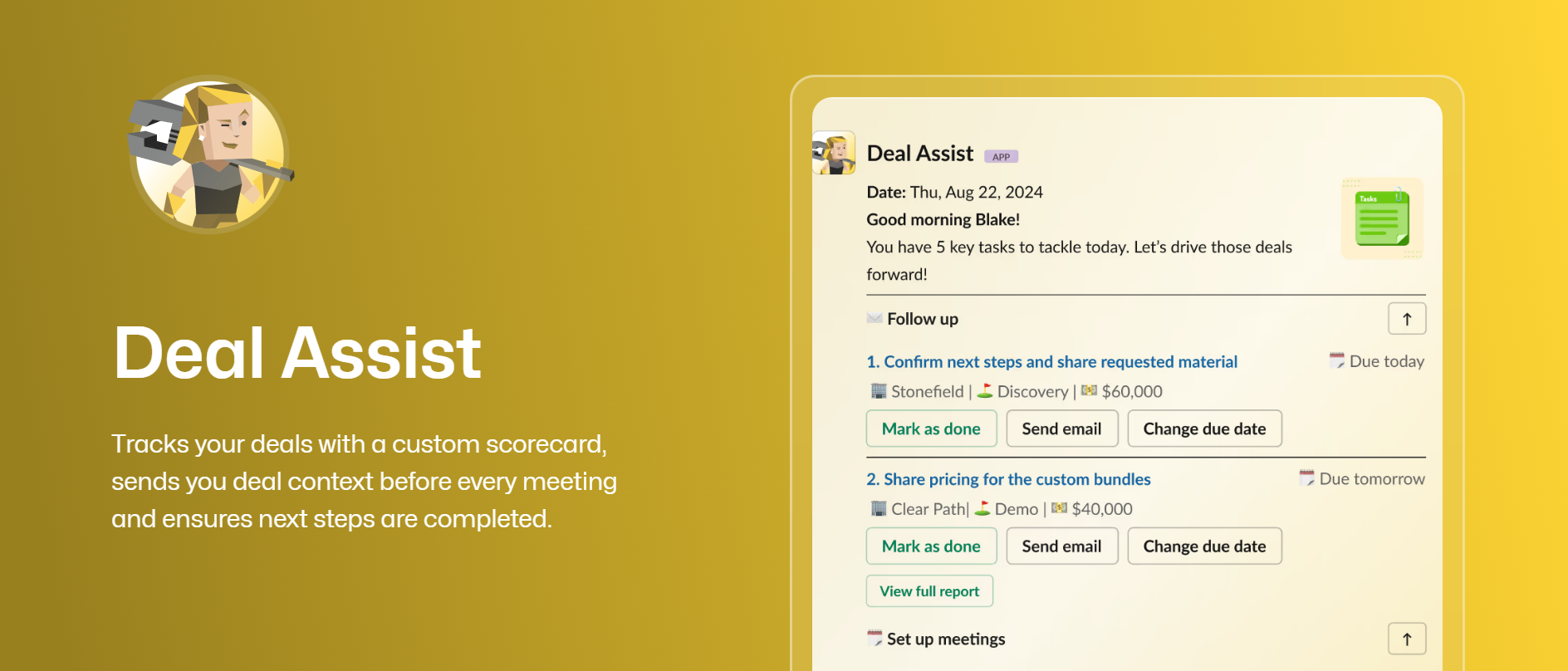
Forecaster Agent | Forecasting & Pipeline Intelligence
- Multilingual Support: Native understanding of 15+ languages for global teams
- Real-time Processing: Instant insights without training delays or false positive management
- Predictive Analytics: Understands sentiment evolution and deal progression patterns
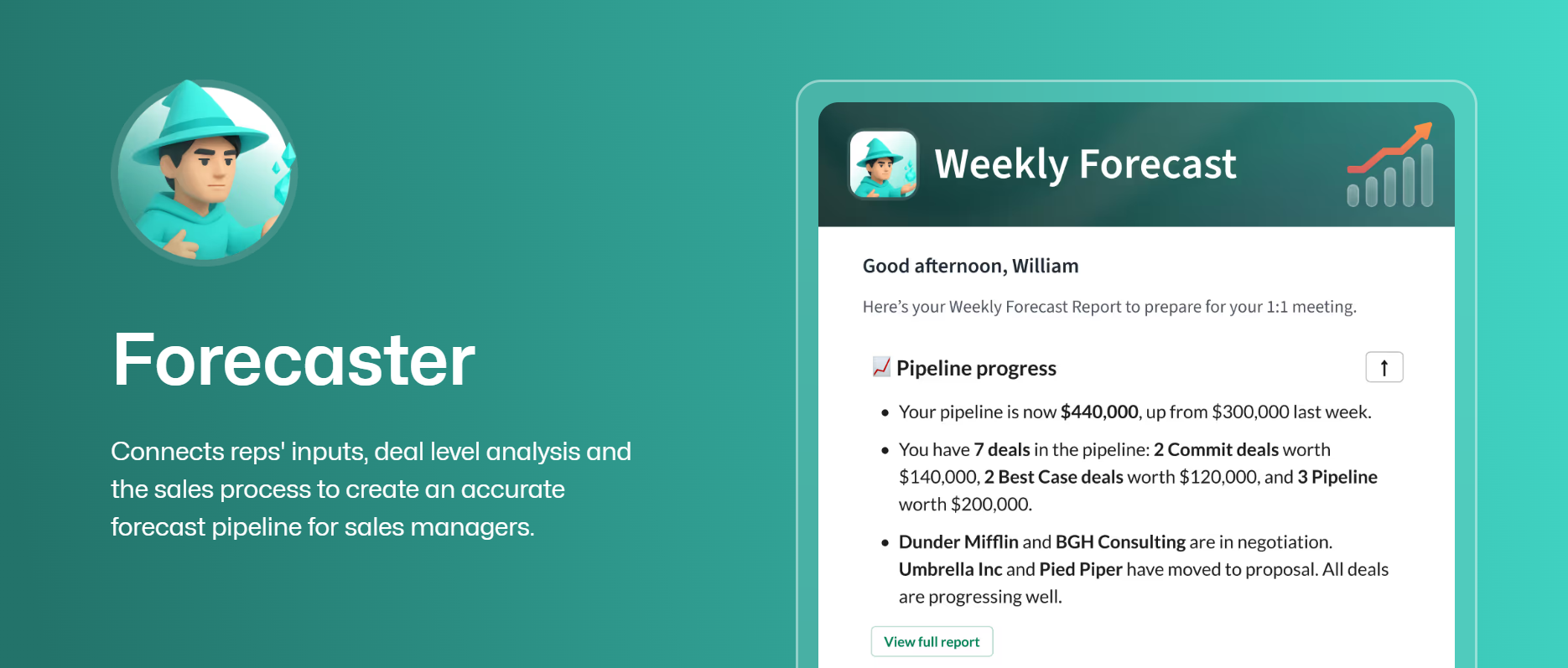
Coach Agent | Coaching & Performance Optimization
- Scalable Architecture: Handles enterprise-level data volumes without performance degradation
- Automated Insights: Delivers actionable coaching recommendations without manual configuration
- Integration-First Design: API-native architecture supports seamless workflow automation
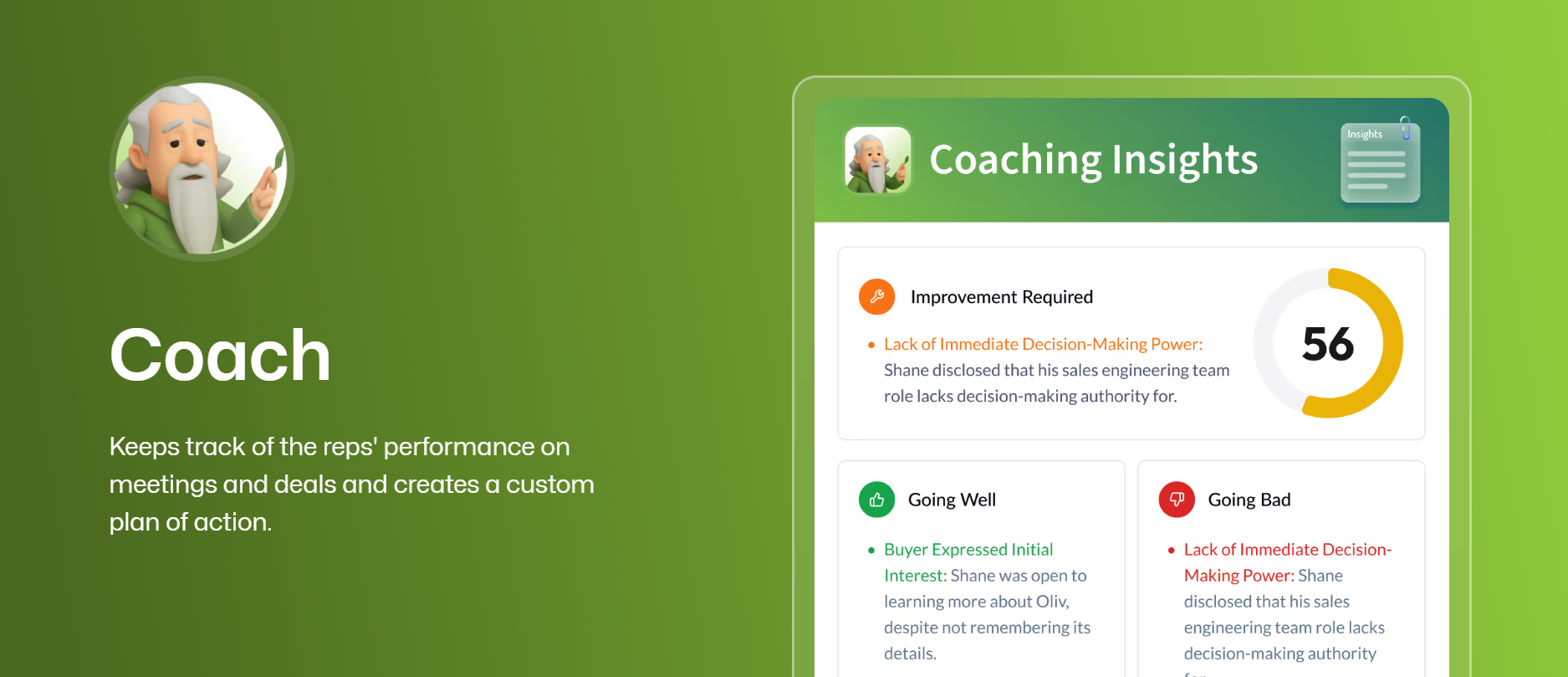
Our fine-tuned LLM approach requires zero manual training, supports global languages from day one, and provides deal-level insights that traditional embedding systems cannot achieve.
Real-World Cost Impact: The $180K Annual Reality
Enterprise sales teams switching from traditional trackers to AI-native platforms report dramatic operational improvements. One mid-market SaaS company documented their pre-switch costs:
Hidden Traditional Costs:
- RevOps Salary Allocation: $72K annually (40% of $180K RevOps manager focused on tracker maintenance)
- False Positive Management: $48K annually (junior analyst role created specifically for data cleanup)
- Delayed Insights Opportunity Cost: $60K annually (deals lost due to 3-6 month setup delays)
- Training and Support: $12K annually (ongoing configuration and troubleshooting)
Total Hidden Cost: $192K annually beyond licensing fees
"It was a big mistake on our part to commit to a two year term. Gong is a really powerful tool but it's probably the highest end option on the market... Having talked with other friends who lead revenue functions, all have said the same thing - they've been fine using a lower cost, simpler alternative."
— Iris P., Head of Marketing, Sales & Partnerships G2 Verified Review
After switching to Oliv.ai, the same company eliminated 100% of manual tracker maintenance, reduced time-to-insight from 6 months to 24 hours, and reallocated their RevOps team to strategic revenue initiatives rather than system administration.
For teams planning change, see our practical guidance on migration from Gong, and evaluate strategic fit through our comparisons: Gong vs Oliv, Gong vs Outreach, Gong vs Chorus, and Gong vs Clari. To understand broader ecosystem choices, review Gong alternatives, Gong pricing insights, and how we streamline Gong Salesforce integrations.
Q4. What’s the True Total Cost of Ownership for Gong Smart Trackers in 2025? [toc=TCO in 2025]
The list price is only the first line on the invoice. For most teams, the real total cost of ownership (TCO) of Gong Smart Trackers emerges over months: higher licensing tiers, data prerequisites that delay value, RevOps time to configure and maintain trackers, and downstream opportunity costs from false positives and missed context. A fair TCO analysis should combine hard dollars (licensing, services, headcount hours) and soft dollars (delayed insights, adoption friction, switching costs).
Visible licensing costs (the starting point)
Gong’s Smart Trackers typically sit behind higher packaging, which means the effective entry point is closer to advanced tiers rather than basic call recording. Organizations often discover add-on costs for complementary modules like Forecast or Engage that improve the value story but push annual spend significantly higher.
- Buyers praise the overall product value and visibility but acknowledge add-on costs: “The additional products like forecast or engage come at an additional cost. Would be great to see these tools rolled into the core offering.” — Scott T., Director of Sales G2 Verified Review
- Small and startup teams frequently report price-to-fit misalignment: “Way too expensive when there are more affordable tools that work… powerful tool but… not the right business decision.” — Iris P., Head of Marketing, Sales & Partnerships G2 Verified Review
- Some mid-market users cite strong value despite price: “Gong has become the single source of truth… easy to gain adoption across the team.” — Scott T., Director of Sales G2 Verified Review
For buyers comparing pricing dynamics and tiers, see our internal analysis of Gong pricing and broader Gong reviews to calibrate expectations, along with adjacent comparisons such as Gong vs Clari and Gong vs Outreach.
Hidden traditional overheads (where TCO balloons)
Beyond licensing, the workload required to make Smart Trackers operational is substantial:
- Configuration and training time
- Multiple rounds of sentence tagging (50–100 examples per custom tracker) and retraining cycles as messaging evolves.
- Ongoing maintenance to tune thresholds and reduce false positives.
- RevOps and admin hours
- 40+ hours per month is common for teams running multiple trackers across products and regions.
- Data governance and export tasks when migrating tools can add unplanned engineering time. “Data access limitations… lack of bulk export… required us to engage our development team at additional cost.” — Neel P., Sales Operations Manager G2 Verified Review
- Adoption and enablement drag
- More powerful systems can be harder to master. “It’s too complicated, and not intuitive at all… searching for calls is not easy.” — John S., Senior AE G2 Verified Review
- Some teams underutilize large portions of the suite: “There’s so much in Gong, that we don’t use everything.” — Karel B., Head of Sales TrustRadius Review
- Support and services variability
- “Since we purchased our package, the support model has changed drastically, which is infuriating.” — Elspeth C., CCO G2 Verified Review
If you’re already on Gong and planning a change, our step-by-step migration from Gong guide outlines data, integration, and change-management considerations. To maintain your existing workflows, reference our deep-dive on Gong CRM integration and best practices for Gong Salesforce integrations.
AI-era efficiency gains (what modern approaches remove)
Modern, generative AI-native platforms reduce TCO in four ways:
- Setup: Natural-language configuration versus sentence tagging eliminates weeks of tracker-building.
- Training data: Minimal examples required (deal-level context) versus high-volume call prerequisites for stability.
- Maintenance: Agents that self-improve reduce routine tuning and false positive cleanup.
- Time-to-insight: Hours to days instead of months, improving coaching cycles, deal velocity, and forecasting confidence.
Balanced perspective: Many teams still realize strong benefits from Gong’s broader platform—coaching, visibility, and centralized deal views are repeatedly praised. “Gong’s product is second to none… helps me coach the team and gain great visibility over our pipeline.” — Elspeth C., CCO G2 Verified Review
For a functional overview of capabilities to weigh against TCO, explore our analysis of Gong features, adjacent tooling choices like best Clari alternatives, and method-by-method Gong vs Salesloft.
Oliv.ai TCO advantage (agent-first, zero-configuration overhead)
We designed Oliv.ai to collapse TCO by replacing manual tracker administration with autonomous agents:
- Zero configuration costs: Describe the outcome; agents build and refine the logic.
- Day 1 utility: Works effectively without 500+ historical calls and avoids multi-round sentence tagging.
- Elastic accuracy: Agents analyze full deal context (meetings, emails, calls) to cut false positives and surface causal rationale.
- Predictable pricing: All capabilities available without stacking multiple modules.
If you’re evaluating options, see Gong vs Oliv and our comparative landscape of Gong alternatives to align architecture and cost model to your stage.
A pragmatic ROI model (how hidden costs add up)
Consider a mid-market team with 30 licenses:
- RevOps time: 20 hrs/month on configuration and maintenance ≈ 240 hrs/year
- Analyst time: 10 hrs/month on false positive cleanup ≈ 120 hrs/year
- Training delays: 3 months delay to accurate insights costs 1 slipped deal/quarter
- Data portability engineering: 40–60 hrs during vendor transitions
Even at conservative blended rates, the soft costs can rival a substantial percentage of license fees. Users echo this dynamic: “Lack of robust data export options has made it hard to justify the platform’s cost.” — Neel P., Sales Operations Manager G2 Verified Review
To be clear, many leaders remain bullish on Gong for its maturity and breadth: “Wouldn’t work at a company who didn’t use Gong… love the UI and the support.” — Alexis F., Sr Director, RevOps & Enablement G2 Verified Review
The TCO question is not whether Gong creates value—it often does—but whether tracker-driven value arrives fast enough and with low enough administrative overhead for the specific stage and resourcing of the organization. For more context on deployment scope and usage patterns, read our breakdown of Gong meeting workflows and pipeline visibility in Gong analytics.
Q5. How Do Modern AI-Native Alternatives Solve These Critical Limitations and Transform Sales Intelligence? [toc=AI-Native Solutions]
The last decade of “conversation intelligence” was built on sentence embeddings, manual configuration, and human-heavy workflows. The generative AI wave of 2024–2025 flips that model. Instead of teaching tools what to look for (keywords, tagged sentences), modern platforms understand business context, stitch together multi-touch narratives across calls, emails, and CRM, and act autonomously. Practically, this means days—not quarters—to value, fewer false positives, and insights that materially improve forecast accuracy, coaching, and deal velocity.
The traditional ceiling: where embedding-era tools hit hard limits
Pre-generative AI systems analyze conversations at the sentence level and require 50–100 examples per custom tracker, retraining cycles, and ongoing admin to maintain signal quality. That architecture drives four persistent problems:
- Context loss: Can’t connect meeting-to-meeting evolution (objection → negotiation → acceptance).
- Configuration drag: RevOps and managers spend hours tagging, tuning, and cleaning noise.
- Data prerequisites: Require large historical call volumes to get stable results.
- Scale friction: Each additional tracker multiplies the maintenance tax and slows teams.
This is why some users love the visibility but struggle with practicality: “It’s too complicated, and not intuitive at all… searching for calls is not easy.” — John S., Senior AE G2 Verified Review. Others value the platform but note add-on costs and sprawl: “The additional products like forecast or engage come at an additional cost.” — Scott T., Director of Sales G2 Verified Review. Data portability and bulk export can further inflate operational overhead: “Lack of bulk export… required us to engage our development team at additional cost.” — Neel P., Sales Ops Manager G2 Verified Review.
For teams assessing ecosystem fit, we recommend reviewing Gong integrations overview and adjacent analyses like Clari reviews & feedback and best Clari alternatives.
What AI-native platforms do differently (and why it matters)
Modern AI-native solutions resolve the seven pain points by design:
- Deal-level understanding, not sentence matching
Foundation models reason over the entire narrative—calls, emails, CRM notes—to interpret objections, consensus, risk, and intent as they evolve. - Minimal setup, natural-language configuration
Instead of sentence-tagging rounds, users describe outcomes (“flag price objection, cite moments”), and agents infer the logic—no retraining cycles. - Faster time-to-value with lower data requirements
Works from day one without needing 500+ historical calls for stability. - Fewer false positives, more causal insights
Evidence-linked explanations show why something was flagged and where it occurred, improving manager trust and rep adoption. - Multilingual, enterprise-grade scale
Global teams gain coverage beyond English; adding new “trackers” doesn’t add admin burden linearly.
To compare operational outcomes across stacks, see our side-by-side coverage of Gong vs Oliv, methodology contrasts in Gong vs Chorus, and prospecting overlaps in Gong vs Salesloft.
Oliv.ai’s agent-first blueprint: autonomous, outcome-driven
We built Oliv.ai as a generative AI-native, agentic platform to eliminate manual tracker administration and deliver business outcomes out of the box.
Deal Driver Agent | Deal Intelligence and Narrative Analysis
- Consolidates all touchpoints (meetings, emails, calls) and reasons over the full deal story.
- Flags risks like pricing objections or competitive threats and cites precise evidence moments.
- Configures via natural language; no sentence tagging or retraining cycles.
Forecaster Agent | Forecast and Pipeline Confidence
- Detects momentum shifts and buyer consensus to adjust forecast confidence—automatically.
- Surfaces “why” behind commit changes (economic buyer identified, legal stalled, budget pending).
- Reduces pipeline inspection time while increasing forecast accuracy.
Coaching Agent
- Generates targeted coaching actions from real conversations: discovery depth, next-step hygiene, objection handling.
- Pushes bite-sized, role-specific feedback; managers coach more, admin less.
- Tracks adoption and outcomes to close the loop on enablement ROI.
For buyers prioritizing security and compliance as they evaluate agentic platforms, see our position on data processing and security, plus broader comparisons like Gong vs Outreach and category-wide Gong alternatives.
Translating architecture into revenue outcomes
- Forecast accuracy: Lifts confidence by grounding predictions in cross-channel buyer signals and consensus building.
- Deal velocity: Removes friction by identifying blockers and prescribing next best actions from evidence.
- CRM hygiene: Auto-enriches fields with accurate, narrative-grounded updates; less rep data entry.
- Coaching effectiveness: Targets behavior that moves deals, not generic talk-time metrics.
- Pipeline confidence: Executive views that explain what changed, why, and what to do next.
Balanced perspective: Many leaders still praise incumbent breadth and maturity—“single source of truth” and strong coaching workflows are common themes. “Gong has become the single source of truth for our sales team.” — Scott T., Director of Sales G2 Verified Review. Others highlight price-to-value and operational friction concerns, especially for smaller teams: “Way too expensive when there are more affordable tools that work.” — Iris P., Head of Marketing, Sales & Partnerships G2 Verified Review.
If you’re exploring a transition to agent-first operations, start with our practical guides: migration from Gong, Gong integrations, and an apples-to-apples Gong vs Oliv comparison to align capabilities with your 2025 revenue plan.
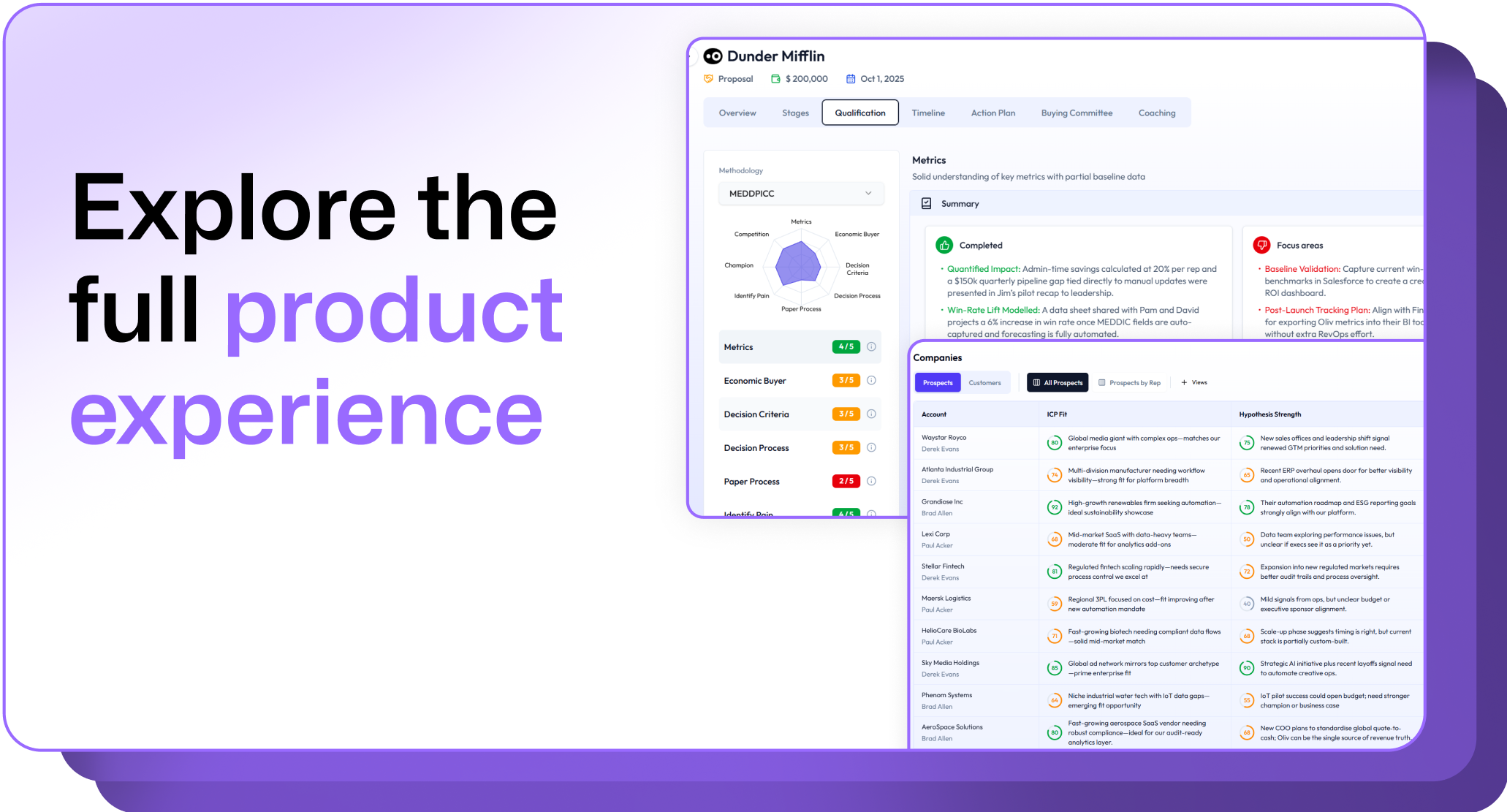
.png)
.png)


.png)
.png)
.png)
.png)

